Thread: Rotating Ballnut - design ideas
-
26-11-2016 #121
First post on this bulletin board; I enjoyed this thread...or at least what I had a chance to read using the spotty WiFi signal at work anyhow.
I find myself in need of a couple of rotating ballnuts for a 3000mm-long 2505 ballscrew, and have come across this older thread on the subject. I was inspired by the designs depicted here, and worked to duplicate/improve upon them when I became curious as to why angular-contact ball bearings were used instead of tapered roller bearings.
I'm trying to keep the unit as compact as possible and I suspect that the tapered roller bearings will help in that respect. The force on the hollow rotating shaft will be primarily axial, along the ballscrew axis with barely any radial load being applied by the tension of the timing belt/pulley.
I came up with the following design (sorry for the seemingly random view angles)--Any comments/input regarding it's viability?:
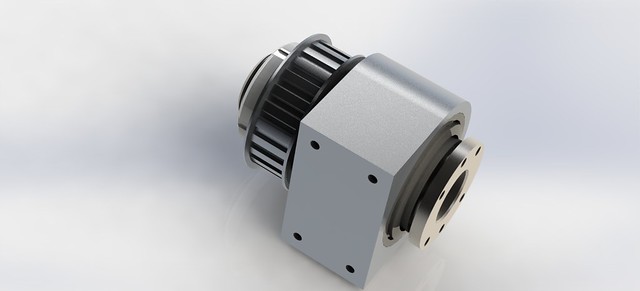
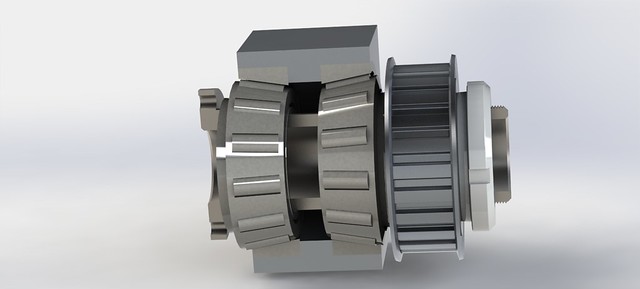
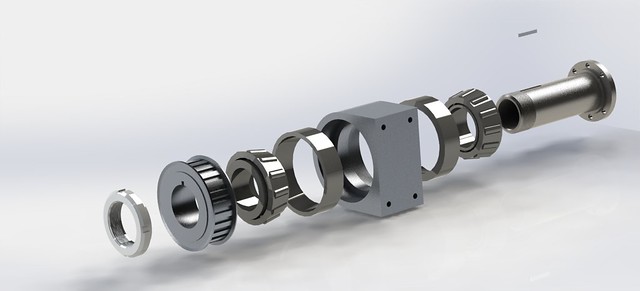
Thanks,
--MarkLast edited by SafeAirOne; 26-11-2016 at 09:32 PM. Reason: Typo/spelling
-
26-11-2016 #122
The bearings that we use here are angular contact ball bearings versus the roller bearings you have drawn in picture. Hiwin and other manufacturers use also ball bearings in their design. I dont know if you are aware of the fact, but for example my bearings and ball screw heat up quite seriously especially when i am doing some crazy fast trochoidal tool paths on wood. In the 20m/min region and good acceleration. Moving 200kg gantry obviously helps that.
The angular contact bearings must be separated at least 1x OD between, having in mind they are 45? degree i think. Obviously roller bearings could be much stronger in all directions load.
Whats the rating of that bearing? RPM?
I am asking my self, what are you trying to gain here? Why would you be braking the assembly to pieces? The motor alignment and ability to tighten correctly the belt while keeping that alignment is a crucial part of the design . Have that in mind. Any small imprecision on a 3 meter scale becomes big imprecision
-
27-11-2016 #123
Thanks for your input.
I didn't realize the bearing and ballnut/screw got significantly hot during machining. I suspect that this will be less of a concern for me as the type of machining I will do will not include much in the line of high-speed toolpaths and rapid moves in general will be at a minimum. I suspect the concern with heat here is in regard to maintaining cutting tolerances and repeatability, as the bearing and screw materials will handle the heat satisfactorily. Is this your understanding as well?
Of course minimizing the contact area and pressure between bearing and race will similarly minimize the generation of heat, which is where the angular contact bearings excel. There's not a whole lot you can do about the ballnut and the ballscrew interaction though.
These are 2788 bearings with 2720 cup. I just had a quick look at Timken's tapered roller bearing engineer's guide and didn't see any indication that the effective bearing spread (distance between bearings) was critical. In fact, I didn't even see where they made any spread recommendations for this type of bearing at all. Interestingly, I just saw that they make a Double Row Tapered Roller Bearing unit that is completely self-contained with a spread much closer than my own design:
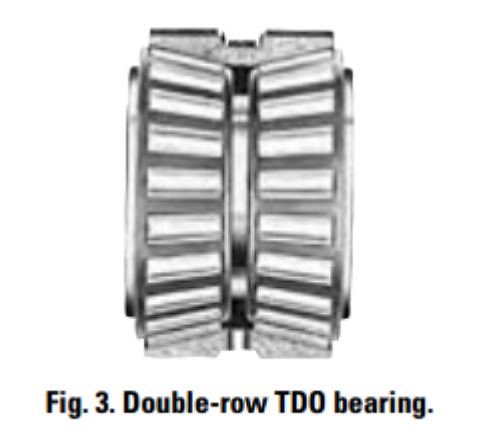
C90 - Dynamic Radial Rating (90 million revolutions): 5060 lbf / 22500 N
C1 - Dynamic Radial Rating (1 million revolutions): 19500 lbf / 86900 N
C0 - Static Radial Rating: 23000 lbf / 102000 N
Ca90 - Dynamic Thrust Rating (90 million revolutions): 2630 lbf / 11700 N
Not sure about RPM, but surely my servo motor at 1:1 or 2:1 pulley ratio will never be able to exceed the limitations of these bearings, I suspect.
My goal is to keep the overall length of the unit as short as possible. Every millimeter of assembly length is a millimeter LESS travel I get out of this axis. The problem I was running into when designing the bearing case as a single piece with the pulley in the middle of the bearings (like the ones you and Jonathan are using), is that the slot to insert the pulley has to be very wide so I'll have enough room to insert the key into the keyway in the shaft, then drop the pulley in and slide it over the key. This makes the whole unit prohibitively long for my application.
I don't believe belt tension will throw the axial alignment off as the pulley is positioned directly against the bearing, minimizing the lever-arm.
Presuming I do the machining carefully and from one side, the axial alignment of the bearings themselves should be just about perfect as the housing is a single piece of aluminum. The servomotor-pulley-to-ballnut-pulley alignment shouldn't be too difficult to handle with a separate, divorced mount, I wouldn't think.
I think the biggest downside to this is the cost of the bearings themselves. I tell myself that these bearings would be a once-in-a-lifetime investment for this machine. It would really stink if this design didn't do the job and I was left with 4 expensive, slightly-used bearings sitting on the shelf for the next 20 years.Last edited by SafeAirOne; 27-11-2016 at 12:15 PM.
-
27-11-2016 #124
The heat comes from the motors. We like to use big macho-Volts to overcome inductance which leads to eddy currents and heat. The problem is, what to do with the heat? You want to dump it in to the machine before your motors demagnetise, but you don't want to get it in the screws because you would be forever worrying about heat expansion.
Will you be oiling those taper rollers? I occasionally run oil down in to my spindle bearings and make a terrible mess. That's a thought maybe it is his choice of lube that is creating the heat.
-
27-11-2016 #125
I believe in my case heat comes from friction. I use grease on ball screw nuts. When i became aware of the heating was when i was machining 8h per day nonstop. So i greased well separately the ball screws and heat lowered, but still there it was. So now i grease very well these elements very often.
But thats why i think the roller bearing is not very suitable. It will generate much more heat due to much bigger contact area for friction. I love overbuilding but i believe this is not the place to do that. Plus the price of the bearings. How much they cost? The Chinese bearings we use normally are not very expensive. 10-15$
-
27-11-2016 #126
As these bearings have no seals, I'd likely use grease. Which type of grease is yet-to-be-determined. The Timken catalog devotes 8 entire pages to lubrication of tapered roller bearings with a myriad of grease recommendations based on usage and environmental conditions.
Plus, I can just add a grease fitting to the hollow area between the bearings in the aluminum housing and grease them both simultaneously during machine maintenance.
The lubricant seems to be the driving factor in how hot these bearings can get; The point at which the various lubricants break down sets the max operating temperature for the bearing.Last edited by SafeAirOne; 27-11-2016 at 02:45 PM. Reason: Added link to Timken Catalog(ue)
-
27-11-2016 #127
I was surprised to see the large price range for the exact same bearing, depending on where you shop.
I initially found the bearing on the McMaster-Carr website (which I love because they have free 3D CAD models of most of the products they sell, making design in Solidworks easy). McMaster-Carr wants $48.00USD (45.00EUR/39.00GBP), but a quick search proves that this is a VERY common bearing. It looks like I can find these same bearings/races, manufactured by Timken, for as low as $19.00USD. Perhaps this isn't going to be as hard on the wallet as I originally envisioned.
I guess this is my question, really: What are the consequences of hot bearings? I imagine the preload will increase due to expansion of the bearing parts, so the bearing life will be reduced (to several million revolutions). Grease life will be reduced (by half for each 10 degrees centegrade of temperature increase!). Other than that, I don't think there will be an impact on machine accuracy or repeatability, unless I'm looking at it wrong.Last edited by SafeAirOne; 27-11-2016 at 03:34 PM. Reason: Added link to McMaster Carr
-
27-11-2016 #128
Having in mind that we are talking 3000rpm here / though some servos can reach as high as 6000, i dont think thats a design consideration. So i think they will work, assembly would be stronger but wear will be premature. In short i would use the normal angular contact bearings as they are more than strong enough for the job.
Size reduction is impossible as the nut should pass through, so that determines the size.
Size reduction in ball screw is absolutely irrelevant as normally you will buy the 3m ball screw as maximum shipping size from China and anyway you need to stretch the ball screw properly on the machine, so you dont need any gain in sizing there, see my second build from signature. As what you loose there from length is the gantry step spread, which is quite more bigger than the rotating nut assembly length.
So in short- you gain absolutely nothing
About the preloaded pair, you have the same in the normal angular bearing. But how do you fix that so it serves you? I see no way.
-
28-11-2016 #129
Hmm. In my mind, the nut attaches to the to the shaft flange and extends AWAY from the bearing housing. To have the ballnut sit INSIDE the hollow rotating shaft would make the bearings, and therefore the whole assembly, prohibitively large (in diameter), at least using a 2505 ballscrew/nut.
Shown with transparent regular ballnut, not the anti-backlash ballnut I plan to use:
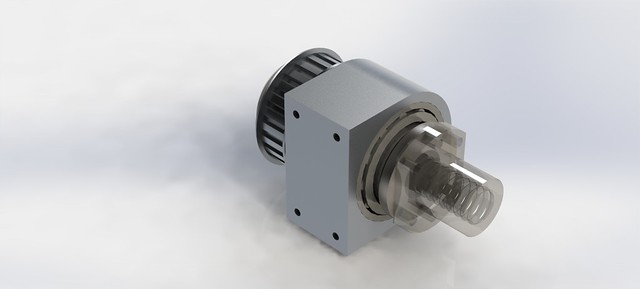
Yes, I have been reading your 2nd build log--I've read the first page, and then skipped to the end, working my way back to the beginning. Very impressive! I see lots of good ideas in your build log. I imagine somewhere in the middle of the thread, I'll come across the change in the machine's purpose, from a CNC air hammer to a CNC router :D
Heh, heh...You know, I hate to say this, but I didn't really consider this. The linear rails that my gantry rides on are 3000mm long. So long as I keep the rotating ballnut assembly shorter than the length of the gantry supports, I'll have EXACTLY the same amount of travel along that axis.
Thanks for pointing this out to me! I think this alone should be cause to re-examine my design; Now that I have all this length to play with, I can explore whether using angular contact ball bearings will allow smaller bearing ODs, which in turn will reduce the distance the stationary ballscrew must be from the machine.Last edited by SafeAirOne; 28-11-2016 at 03:43 AM. Reason: Changed image
-
28-11-2016 #130
Thread Information
Users Browsing this Thread
There are currently 1 users browsing this thread. (0 members and 1 guests)
Similar Threads
-
Rotating Ball nut
By drumsticksplinter in forum Lead Screws, Nuts & SupportsReplies: 30Last Post: 12-05-2020, 08:01 PM -
Interesting Papers on heavy duty design, vibrations, composites and column design
By D.C. in forum Gantry/Router Machines & BuildingReplies: 15Last Post: 25-06-2016, 10:13 PM -
Rotating Ballnut Design MK3
By Jonathan in forum Linear & Rotary AssembliesReplies: 0Last Post: 15-12-2013, 01:35 PM -
advice on floating bearing - outer ting rotating
By dsc in forum Lead Screws, Nuts & SupportsReplies: 8Last Post: 18-11-2013, 02:23 PM -
Design help etc required with DIY CNC Router Design / Build
By MikeyC38 in forum Gantry/Router Machines & BuildingReplies: 12Last Post: 21-10-2011, 04:50 PM







 Reply With Quote
Reply With Quote









Bookmarks